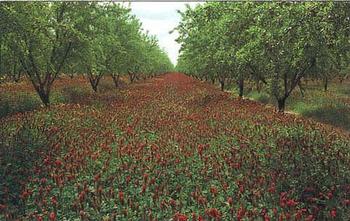HSP in cropland
Cropland Practices
Croplands practices reduce erosion and increase the carbon sequestration potential of a field under cultivation.
- Cover cropping
- Planting a crop that will not be harvested or grazed. This can improve water holding capacity and penetration and soil fertility but it can also increase irrigation needs. (https://efotg.sc.egov.usda.gov/references/public/CA/340-std-10-11.pdf)
- Conservation crop rotation
- A planned crop rotation that uses the qualities of the different crops to reduce erosion and nutrient loss (https://efotg.sc.egov.usda.gov/references/public/CA/328-std-ca-8-16.pdf)
- Mulching
- Applying plant residues, like wood chips, dead cover crops, or compost, to the land. (https://efotg.sc.egov.usda.gov/references/public/CA/484_std_ca_8-18.pdf)
- Nutrient management that reduces synthetic fertilizer use by 15%
- Producing a nutrient management plan that improves nutrient application efficiency and timing so that overall synthetic fertilizer use decreases by at least 15% (https://efotg.sc.egov.usda.gov/references/public/CA/590-std-ca-9-16.pdf)
- No till
- Managing crops without disturbing the soil with tillage operations. (https://efotg.sc.egov.usda.gov/references/public/CA/329-std-ca-10-12.pdf)
- Reduced till
- Managing crops by only tilling the soil when absolutely necessary and leaving as much soil undisturbed as possible (https://efotg.sc.egov.usda.gov/references/public/CA/345-std-ca-11-14.pdf)
- Strip cropping
- Growing strips of erosion-resistant crops in between the strips of crops that are more susceptible to erosion, to decrease the overall erosion potential of a field (https://efotg.sc.egov.usda.gov/references/public/CA/585_std_ca_8-18.pdf)

